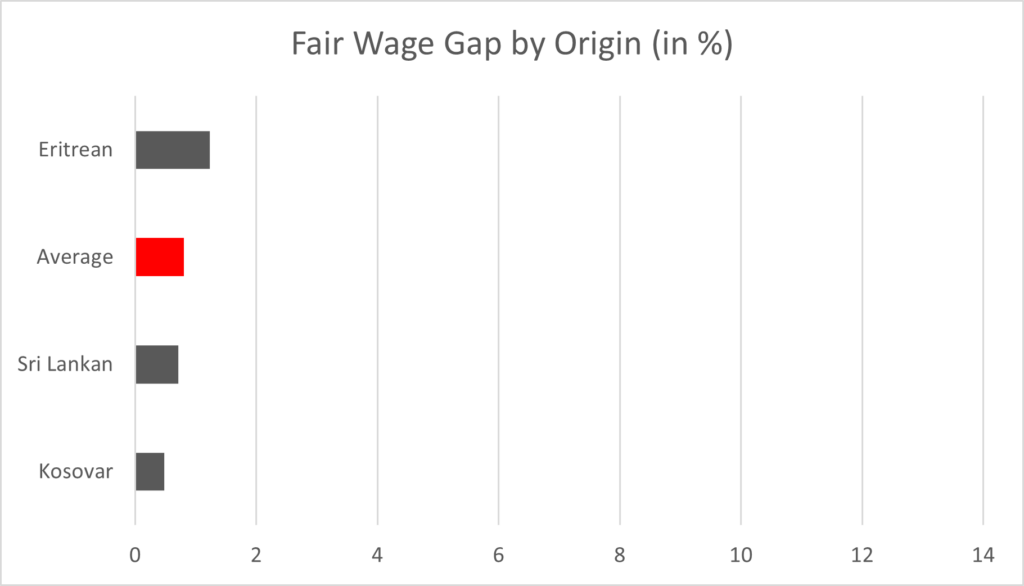Does an Immigrant-Native Wage Gap Exist? And Is It Fair?

People with a migration background face many barriers in the labor market. Research has shown that they have fewer chances of being invited for job interviews or being offered a promotion, and when they do get a job, they may well earn less or face worse working conditions. Much less is known about other forms of labor market discrimination, however. It seems therefore interesting to investigate whether immigrants face wage discrimination and whether people think this wage gap is fair.
While most people agree that there is a gender wage gap (i.e., women earn on average about 20% less than men in OECD countries), there is no real consensus on whether immigrants face wage discrimination. To investigate whether immigrant wage discrimination takes place, we first need to define what we mean by discrimination. It could be that immigrants simply earn less because they are on average less educated or do not speak the local language. Moreover, some people might argue that they are just less smart or simply lazy.
Ideally, we should compare the wage of the same person with and without the migration background – which is not possible. A perfect alternative way to measure wage discrimination has not yet been found, which could be one of the reasons why different studies find very different results.
Our Approach
We searched all existing studies and papers mentioning wage, income, or pay; discrimination, differences, or gaps; and immigrants, or ethnic minorities. Looking for these search terms, we found 4,745 studies. Luckily for us, many of these studies did not actually estimate wage discrimination. Some of them talked about migratory salmon and could be eliminated quickly. In the end, we identified 364 studies that estimate wage discrimination for immigrants or ethnic minorities. In these studies, we looked at (i) what the study finds, (ii) which immigrants or ethnic minorities they take into account, (iii) what method they used, (iv) where they did the study and (v) when. We then included all these elements into a model to estimate first what the average wage gap was, and second, which of these five elements had a significant effect on the estimated wage gap.
Our Findings
We found that immigrants earned on average about 6% less than natives. This variation might not seem to be huge, but if we take a closer look, we can see that there are big differences depending on the origin of the immigrant. That is, immigrants coming from Europe earn around 4% less, and immigrants from Africa up to 13% less than their local counterparts.
Could the Wage Gap Be Considered Fair?
Now that we found that immigrants – and especially people with African origins – were being paid less, the next question we wanted to know was whether this was considered “normal” or “fair” to people. If we again would make the analogy with the gender wage gap, earlier research in Germany has shown that people think it is “fair” that a woman doing the same job and having the same qualifications as a man, earns 12% less, which is more or less equal to the actual wage gap in Germany (Auspurg, Hinz & Sauer, 2017).
While we do not know whether this is because everybody agrees that a woman is valued less than a man (and so we should not worry about the wage gap), or because the wage gap has been so consistent that people simply started taking it for granted, we still wanted to know whether a similar “fair” wage gap exists for immigrants, and how it compares to the actual wage gap.
How Did We Proceed?
In order to estimate the “fair” immigrant-native wage gap, we did an experiment where we showed people the description of a person (including their gender, origin, experience and skill), their occupation, and how much they earned. We then asked them to say whether they thought these earnings were fair, too low, or too high. The different elements in these profiles changed randomly, meaning that they were as likely to see a medical doctor from Switzerland or Eritrea (which is of course not true if we would look at real data).
Because these elements are random, we could look at how much each of these elements impact how fair the earnings were rated, independently from the other elements. In other words, since the origin of a fictitious person is by design completely independent of their skills, experience and occupation, we could say that if the earnings of one group are rated significantly more or less fair than the earnings of another group, this would only be due to their origin. If we found a significant difference, we could say that there was a “fair” immigrant-native wage gap.
We Should Really Address Wage Discrimination
Overall, we found that the person’s origin only has a small and insignificant impact on how fair the earnings of a person were rated. Nevertheless, if we calculate the “fair” immigrant-native wage gaps by origin, we found the same order as when looking at the actual wage gaps. I.e., people from Eritrea (chosen because they are the biggest immigrant group from Africa in Switzerland) have the highest “fair” wage gap, followed by people from Sri Lanka (Asia) and Kosovo (Europe). The order of magnitude is however very different.
Where people in Switzerland consider 1% fair for Eritreans, we saw that the actual average wage gap (worldwide) for people from Africa was 13%. The observed average wage gaps are indeed larger for all groups than the “fair” wage gaps. This leads us to believe that wage discrimination is more prominent than what people consider acceptable and should therefore be addressed.
Eva Van Belle – is an assistant professor at the Vrije Universiteit Brussel and a researcher in the nccr – on the move project ‘Overcoming Inequalities with Education.’ Her research focusses on labor market discrimination and policy evaluation.
Reference:
-Auspurg, K., Hinz, T., & Sauer, C. (2017). Why should women get less? Evidence on the gender pay gap from multifactorial survey experiments. American Sociological Review, 82(1), 179-210.




